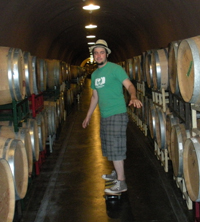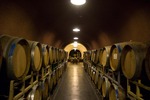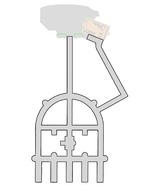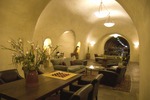Entries in cave (3)
About Barrels
 Wednesday, August 19, 2009 at 9:23PM
Wednesday, August 19, 2009 at 9:23PM I've been working a lot more inside the cave recently, which is something I really enjoy. The floor of the cave is paved with really smooth cement and I use a skateboard to get around everywhere. It's not really conventional but I think that making wine is all about being unconventional. I suppose that's a very Californian approach to winemaking and I'm sure that the exact opposite is true in France but we'll talk more about the West Coast approach some other time. So far I've been doing two important jobs: Topping the wine barrels and gassing them.
Topping wine barrels isn't very difficult and it's one of the only things at the winery that I know how to do without asking for any assistance. The only thing that makes it challenging is when the barrels are stacked really high or too close to a wall. Before I go any farther I want to get something out of the way: The hole on the side of the barrel where you put the wine in is called the bunghole. The thing you put in the bunghole is called a bung. Done snickering? Ok, good, I'm glad you got that out of your system. Unlike racking, barrel topping is a straightforward term. As the wine continues fermenting in the barrel a small amount of it evaporates. That leaves room in the barrel for air to seep in. And because the last thing you want is for your wine to be exposed to air for a year, Cellar Rats like myself can be seen scurrying from barrel to barrel, topping them off. For the same reason that you top off, you can't leave any half-full barrels lying around. So any wine that's leftover is put in a metal keg (that air can't seep into) which nitrogen is then added to in order to force out any O2. If you can, you use the same wine to top off the other barrels but most of the time there's not any leftovers of that particular wine to use. So the standard practice is to use another similar wine and because such a small amount is added there is no real change. A fine wine like the ones that Deerfield produces is made using the cleanest practices possible. And so, even for a simple thing like adding a little bit of wine to a barrel, strict sanitation procedures are observed: I scrub around the bung using proxy and citric; Then I rinse with some water; Then I remove the bung and place it upside down on the barrel; If the bung is dirty I replace it with a clean one; I add the wine using a sanitized air pump; Then I put the bung back and the barrel is rinsed again; Lastly I spray a solution of sulphur dioxide to kill any lingering bacteria. Typically I'll do this for several hundred barrels in a day.
The other thing I've been doing is gassing the empty barrels. When the barrels sit empty in the cave lots of bad things can happen. Between beetles and bacteria, a winemaker needs an offensive weapon to make sure those fine oak barrels stay usable until they're next needed for service. So I spray a gaseous form of SO2 into the barrels and stick a little Dixie cup in the bunghole and slap a piece of masking tape on it for good measure. I learned the hard way the importance of wearing a gas mask while doing this. I was coughing and wheezing for a good thirty minutes. So now I wear this big awesome Darth Vader looking thing whenever I'm adding the gas. I also wear my big DJ-style headphones while I work in the cave. The effect is that I look kind of like one of the aliens from the Fifth Element.
Well I've got one more story from this past week but I am exhausted so it will have to wait until tomorrow! I'll be talking about decanting and the virtues of proper bin-city planning. Cheers!
Alternative Transportation
 Thursday, May 6, 2010 at 2:38PM
Thursday, May 6, 2010 at 2:38PM It's easy to get lost sometimes in 23,000 square feet of caves but it's even harder to find somebody. Working at the winery requires a lot of teamwork and communication. There's always some question that you have to ask somebody in particular. Has the Petit Verdot been punched down yet today? Have you seen the alcohol spray bottle? Are you done using the air pump outside? Have you seen the alcohol spray bottle? Can you move these barrels with the forklift? Have you seen the alcohol spray bottle?!?! The cave has two entrances and there's been many-a-times when I've played a game of cat and rat - You go in one end looking for Ryan and he comes out the other looking for you, going round and round till one of you gives up and that's when you end up finding each other. And those caves are BIG! It takes a few minutes to walk all the way to the back of the cave and make a full loop. The cave sometimes seems like it has a personality; a very mischievous and playful personality. It loves to play tricks on you. When you call out somebody's name, their answer occasionally bounces off the walls in such a way that it seems to come from the opposite direction. Or it loves to change the quality of people's voices so that you think you're closing in on your target but in fact, when you round the corner, it's somebody else entirely waiting for you. During the hustle and bustle of harvest time is a precious commodity and I decided that if I could just get around the cave faster maybe (just maybe) we could get the job done before dark.
Hmmm.... What wheeled personal transportation device could I use to get around the smooth even surfaces of the cave? Aha! A skateboard seems like such a contraption! Except I didn't really know how to ride a skateboard very well... At first I managed quite well with the small exception that I couldn't turn left. But after a month of practice I became a full-fledged ambi-turner and the only rat I know on wheels. It sounds funny but it really is the best way to travel - I could get to and from a work area quickly and find people in a flash (No more games of cat and rat because I could overtake somebody looking for me). The only thing is that the floor gets wet so I have to be careful not to skate through any puddles. I bought a skate board with griptape that looks like caution tape so that I remember whenever I ride it that I'm in a work zone! What's next - a skate park in a wine cave? Stranger things have happened!


 cave
cave The Cave - Home Of The Cellar Rat
 Wednesday, February 23, 2011 at 1:23PM
Wednesday, February 23, 2011 at 1:23PM  Home Sweet HomeThe Cave is really home to the Cellar Rat, which is why I'm surprised that I haven't spoken more about it. The obvious question is why put wine in a cave in the first place? Wine is picky about its environment. It ages best in a very specific temperature and humidity range that remains constant. Serendipitously, shallow caves happen to provide exactly such an environment. Another modern solution to wine aging and storage is the climate controlled warehouse. It takes a great deal of energy to cool such a large space, so caves are really a much greener option and cost effective as well - I have it on good authority that building a cave is less expensive per square foot than any other structure. Building a modern wine cave is a very exciting endeavor. The digging machine that buried into the earth like a massive mechanical mole looked like the imaginings of Jules Verne.
Home Sweet HomeThe Cave is really home to the Cellar Rat, which is why I'm surprised that I haven't spoken more about it. The obvious question is why put wine in a cave in the first place? Wine is picky about its environment. It ages best in a very specific temperature and humidity range that remains constant. Serendipitously, shallow caves happen to provide exactly such an environment. Another modern solution to wine aging and storage is the climate controlled warehouse. It takes a great deal of energy to cool such a large space, so caves are really a much greener option and cost effective as well - I have it on good authority that building a cave is less expensive per square foot than any other structure. Building a modern wine cave is a very exciting endeavor. The digging machine that buried into the earth like a massive mechanical mole looked like the imaginings of Jules Verne.  Cave FloorplanThe process of digging the cave, we discovered, is very organic: You start with a plan of what you want and then the foreman comes back to you halfway through and says "Okay, we hit granite. You can keep going the way it says on the plan and it will cost you $100,000 or you can go this way and it will cost $10,000." On the original plan the cave is designed like a wheel with spokes leading into the center. It was definitely destiny morphed into the current configuration because the finished cave layout is in the shape of a wineglass.
Cave FloorplanThe process of digging the cave, we discovered, is very organic: You start with a plan of what you want and then the foreman comes back to you halfway through and says "Okay, we hit granite. You can keep going the way it says on the plan and it will cost you $100,000 or you can go this way and it will cost $10,000." On the original plan the cave is designed like a wheel with spokes leading into the center. It was definitely destiny morphed into the current configuration because the finished cave layout is in the shape of a wineglass.
They use the massive machine to dig and cart away the dirt and then they cover the walls with spray-on concrete called shockcrete. The shape of the tunnels provides the real strength of the cave, however, where the winery building will eventually sit on top of the cave, steel girders are stretched into an arch which can hold an enormous load. The strength of this shape has been known since Roman times. Interestingly, it is the concrete floor that holds the ends of the girder in place, so the floor is really what keeps everything together as you can see in the diagram. Another layer of shockcrete is applied and then they cover it with whatever finish you like, such as plaster. In all of the working sections of the cave we left the shockcrete bare because it looks nice but it turned out to be the bane of cellar rats - its jagged surface is as treacherous as volcanic rock. It's slow going when you're working in the tight space between the wall and the barrels.
Deerfield's cave is state-of-the-art: Compressed air is provided throughout the cave, as well as lines for inert gases like nitrogen and argon. There is even copper wire buried in the floor to provide wireless signals! My uncle Martin, our General Manager, even hooked up every switch to our main server, so that potentially, if you wanted to, you could dim the lights from Paris.  The Tasting RoomThe cave is 23,000 sq. ft. and holds about 3000 barrels - that's a lot of wine! Unique to Deerfield's cave is the Grand Room which lays in the very heart of it. This amazing space is currently where our tasting room is located, so when you visit you get to go spelunking. Deerfield’s caves were designed by the winemaker’s brother and my father, Michael Rex.
The Tasting RoomThe cave is 23,000 sq. ft. and holds about 3000 barrels - that's a lot of wine! Unique to Deerfield's cave is the Grand Room which lays in the very heart of it. This amazing space is currently where our tasting room is located, so when you visit you get to go spelunking. Deerfield’s caves were designed by the winemaker’s brother and my father, Michael Rex.
 cave
cave 
